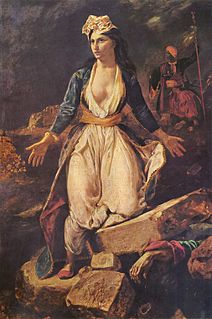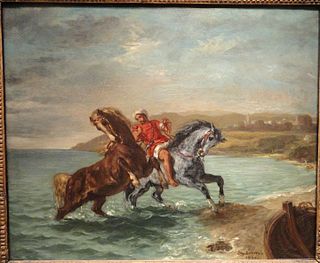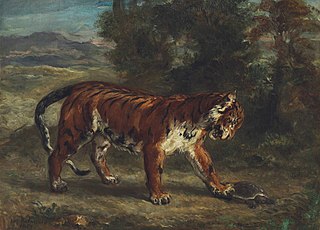 W
WThe Abduction of Rebecca is a mid-19th century painting by French artist Eugène Delacroix. Done in oil on canvas, the work depicts the a scene from Sir Walter Scott's novel Ivanhoe in which the heroine Rebecca is abducted. Delacroix produced the painting during the height of the French Romanticist Movement, and presented the work at the Paris Salon of 1846. The 1846 version of Abduction is currently in the collection of the Metropolitan Museum of Art, which describes the work as "one of Delacroix’s greatest paintings". in 1858 Delacroix created an almost identical work for the Paris Salon of 1859; the second version of Abduction is in the collection of the Louvre.
 W
WArab Horses Fighting in a Stable is an 1860 Orientalist painting by Eugène Delacroix, signed and dated by the artist and now in the musée d'Orsay.
 W
WArab Rider Charging is a small 1832 Orientalist oil on canvas painting by Eugène Delacroix, dated and signed by the artist. It is now in a private collection It shows an Arab rider charging at the gallop.
 W
WThe Barque of Dante, also Dante and Virgil in Hell, is the first major painting by the French artist Eugène Delacroix, and is a work signalling the shift in the character of narrative painting, from Neo-Classicism towards Romanticism. The painting loosely depicts events narrated in canto eight of Dante's Inferno; a leaden, smoky mist and the blazing City of the Dead form the backdrop against which the poet Dante fearfully endures his crossing of the River Styx. As his barque ploughs through waters heaving with tormented souls, Dante is steadied by Virgil, the learned poet of Classical antiquity.
 W
WThe Battle of Nancy is an 1831 painting by Eugène Delacroix, showing the 1477 Battle of Nancy and the death of Charles the Bold.. It is now in the Musée des Beaux-Arts de Nancy. Nancy's 'société royale des sciences, lettres et arts' suggested three possible subjects - the battle itself, Lorraine's victory over the Burgundians or the discovery of Charles the Bold's body - Delacroix chose the first of these, but did not go to Nancy in person, instead basing the work on several preparatory sketches of medieval weapons and costumes, of scenes from literature such as Walter Scott's Anne of Geierstein and of topographical maps provided by baron Schwitter
 W
WThe Battle of Taillebourg, 21 July 1242 is an 1837 painting of the Battle of Taillebourg by Eugène Delacroix, one of 33 huge works commissioned from different artists by Louis-Philippe I for his Gallery of Battles at the Palace of Versailles, inaugurated in 1837. It still hangs there, between Horace Vernet's The Battle of Bouvines, 27 July 1214 and Charles-Philippe Larivière's The Battle of Mons-en-Pévèle, 18 August 1304. It is Delacroix's only work in the Gallery and probably his only work in the whole Versailles complex.
 W
WThe Bride of Abydos or Selim and Zuleika is the title of two works by Eugène Delacroix, one in the Museum of Fine Arts of Lyon (pre-1849) and another in the Louvre (1843–1849).
 W
WChrist Asleep during the Tempest is a c.1853 oil on canvas painting by the French Romantic artist Eugène Delacroix. The painting is currently on display at the Metropolitan Museum of Art in New York City.
 W
WChrist on the Cross, Christ between Two Thieves or Calvary is an 1835 painting by Eugène Delacroix.
 W
WThe Death of Sardanapalus is an oil painting on canvas by Eugène Delacroix, dated 1827. It currently hangs in the Musée du Louvre, Paris. A smaller replica, painted by Delacroix in 1844, is now in the Philadelphia Museum of Art.
 W
WThe Entombment of Christ is an 1820 painting by the French artist Eugène Delacroix, constituting a minor reworking of The Entombment of Christ, a c.1520 work by Titian. He left it to his pupil Paul Chenavard, who in 1881 left it to the musée des Beaux-Arts de Lyon, where it still hangs.
 W
WThe Entry of the Crusaders in Constantinople or The Crusaders Entering Constantinople is a large painting by Eugène Delacroix. It was commissioned by Louis-Philippe in 1838, and completed in 1840. Painted in oil on canvas, it is in the collection of the Musée du Louvre in Paris.
 W
WGreece on the Ruins of Missolonghi is an 1826 oil painting by French painter Eugène Delacroix, and now preserved at the Musée des Beaux-Arts de Bordeaux. This painting was inspired by the Third Siege of Missolonghi by the Ottoman forces in 1826, during which many people of the city after the long-time siege decided to attempt a mass breakout (sortie) to escape famine and epidemics. The attempt resulted in a disaster, with the larger part of the Greeks slain.
 W
WHead of a Woman was painted using graphite in 1823 by the French Romantic artist Eugène Delacroix (1798–1863) as a study for his 1824 The Massacre at Chios. The woman is tightly framed and shown gazing upwards in fear. Her black dress, long dark hair and features are rendered using chiaroscuro. Today the painting is part of the collection of the Fine Arts museum of Orléans, France.
 W
WThe Church of Saint-Sulpice is a Roman Catholic church in Paris, France, on the east side of Place Saint-Sulpice, in the Latin Quarter of the 6th arrondissement. It is only slightly smaller than Notre-Dame and thus the second largest church in the city. It is dedicated to Sulpitius the Pious. Construction of the present building, the second church on the site, began in 1646. During the 18th century, an elaborate gnomon, the Gnomon of Saint-Sulpice, was constructed in the church.
 W
WHorses Leaving the Sea or Horses Coming Out of the Sea is an 1860 oil on canvas painting by Eugène Delacroix, signed and dated by the artist and now in The Phillips Collection in Washington. Relatively atypical in Delacroix's oeuvre, it shows two horses leaving the sea led by a Moroccan rider, with the town of Tangiers in the background. It was produced for the same art dealer as Arab Horses Fighting in a Stable and is usually regarded as a pair with that work
 W
WThe Kaïd, A Moroccan Chief is an 1837 Orientalist oil on canvas painting by the French artist Eugène Delacroix, signed and dated by the painter himself and now in the Musée d'Arts de Nantes It is also known as Offering Milk, Arab Chief Among His Tribe and The Halt, or The Kaïd Accepting the Shepherds' Hospitality
 W
WLast Words of the Emperor Marcus Aurelius is an 1844 painting by the French artist Eugène Delacroix, now in the Museum of Fine Arts of Lyon. A preliminary sketch of the painting that was given to Delacroix's student Louis de Planet is also kept in the museum.
 W
WLiberty Leading the People is a painting by Eugène Delacroix commemorating the July Revolution of 1830, which toppled King Charles X of France. A woman of the people with a Phrygian cap personifying the concept of Liberty leads a varied group of people forward over a barricade and the bodies of the fallen, holding the flag of the French Revolution – the tricolour, which again became France's national flag after these events – in one hand and brandishing a bayonetted musket with the other. The figure of Liberty is also viewed as a symbol of France and the French Republic known as Marianne.
 W
WLion Devouring a Rabbit is a c.1855 painting by the French artist Eugène Delacroix, now in the Louvre in Paris.
 W
WThe Lion Hunt is a series of oil on canvas paintings produced by the French artist Eugène Delacroix in the mid-1800s.
 W
WLouis d'Orléans Showing Off His Mistress is an 1825–1826 painting produced by the French artist Eugène Delacroix, now in the Thyssen-Bornemisza Museum in Madrid. It shows Louis I, Duke of Orléans, his chamberlain Albert Le Flamenc and Mariette d'Enghien, who was both Le Flamenc's wife and the Duke's mistress. It draws on an episode recounted in both Prosper de Barante's Histoire des ducs de Bourgogne de la maison de Valois and Brantôme's Vie des dames galantes. It shows strong influence from Rubens and Titian as well as from Richard Parkes Bonington, a British artist with whom he actively swapped ideas and sketches between 1825 and 1828.
 W
WMademoiselle Rose is a painting by French Romantic artist Eugène Delacroix, regarded as the leader of the French Romantic school. This nude was painted before 1824, and is currently held and exhibited at the Louvre in Paris. Another is at the Alte Nationalgalerie in Berlin.
 W
WThe Massacre at Chios is the second major oil painting by the French artist Eugène Delacroix. The work is more than four meters tall, and shows some of the horror of the wartime destruction visited on the Island of Chios in the Chios massacre. A frieze-like display of suffering characters, military might, ornate and colourful costumes, terror, disease and death is shown in front of a scene of widespread desolation.
 W
WThe Murder of the Bishop of Liège is an 1828 or 1829 oil on canvas painting by Eugène Delacroix, showing the murder of Louis de Bourbon, Bishop of Liège by William I de La Marck's men during the 15th-century Wars of Liège, as told in chapter 22 of Walter Scott's historical novel Quentin Durward. First exhibited at the Paris Salon of 1831, it is now in the Louvre in Paris.
 W
WThe Orphan Girl at the cemetery is a painting by the French artist Eugène Delacroix.
 W
WOvid among the Scythians is the title of two oil paintings by French artist Eugène Delacroix. The less famous second version was painted to integrate the figures and landscape and rectified the problems of scale of the first version, which had an unusual composition and strange scale of the characters, provoking negative criticism, even among Delacroix's admirers such as Baudelaire and Gautier, although artists like Edgar Degas were deeply impressed.
 W
WThe Portrait of Frédéric Chopin and George Sand was an 1838 unfinished oil-on-canvas painting by French artist Eugène Delacroix. Originally a double portrait, it was later cut in two and sold off as separate pieces. It showed composer Frédéric Chopin (1810–49) playing piano while writer George Sand (1804–76) sits to his right, listening and sewing. The sitters were lovers at the time, and both were close friends of the artist.
 W
WPortrait of Louis-Auguste Schwiter is an 1826-1830 portrait by Eugène Delacroix of the son of Henri César Auguste Schwiter. It was once owned by Edgar Degas and was acquired in 1918 by the National Gallery, London, which still owns it.
 W
WThe Sultan of Morocco is an 1845 oil on canvas painting by the French Romantic and Orientalist painter Eugène Delacroix, now in the Musée des Augustins de Toulouse. Its full title is Moulay Abd-Er-Rahman, Sultan of Morocco, leaving his palace of Meknès, surrounded by his guards and his principal officers. It shows the seventh sovereign of the Alaouite dynasty.
 W
WTiger with a Tortoise or Tiger Playing with a Tortoise is an 1862 oil on canvas painting by Eugène Delacroix. It was sold by Christie's in New York for $ 9,875,000 in May 2018
 W
WThe Two Foscari is an 1855 painting by Eugène Delacroix, now in the Musée Condé in Chantilly.
 W
WWarrior by a Tomb, Arab by a Tomb or The Arab by the Tomb is an 1838 oil on canvas painting by Eugène Delacroix, now in the Hiroshima Museum of Art. It was inspired by his trip to Morocco as an official painter, but was refused by the jury of the Paris Salon.
 W
WWoman Stroking a Parrot or Woman with a Parrot is an 1827 Orientalist oil on canvas painting by Eugène Delacroix. Several art historians have linked the work to Lambert Sustris's Venus and Cupid. In 1897 the painting was given by Couturier de Royas to the Museum of Fine Arts of Lyon, where it still hangs.
 W
WWomen of Algiers in their Apartment is the title of two oil on canvas paintings by the French Romantic painter Eugène Delacroix.
 W
WA Young Tiger Playing with its Mother is a painting of 1830–31 by French artist Eugène Delacroix depicting two enormous tigers "playing" with each other. Painted early in his career, it shows how the artist was attracted to animal subjects in this period. The painting was exhibited at the Salon of 1831, and archives of Delacroix's will executor, Achille Piron, revealed that the painter had paid 1,200 francs to insure it. It belonged to M. Maurice Cottier and now is on display at Room 77 of Louvre in Paris.